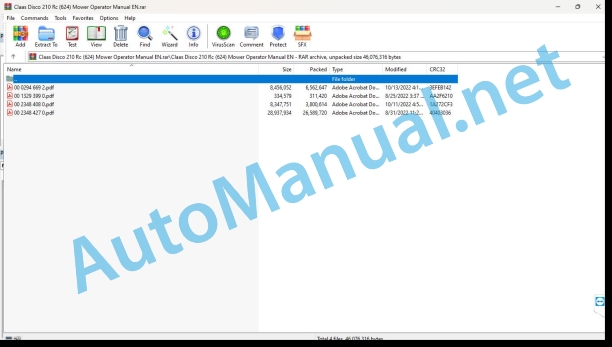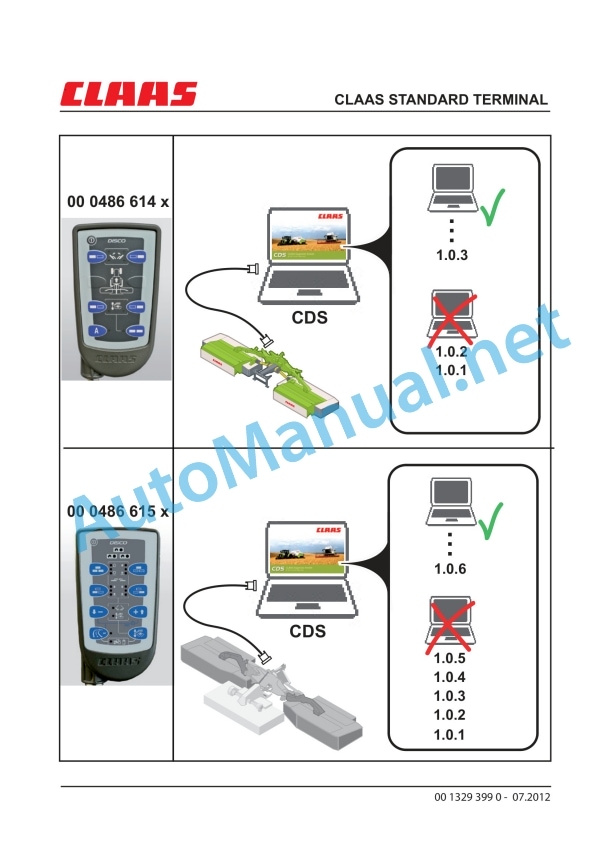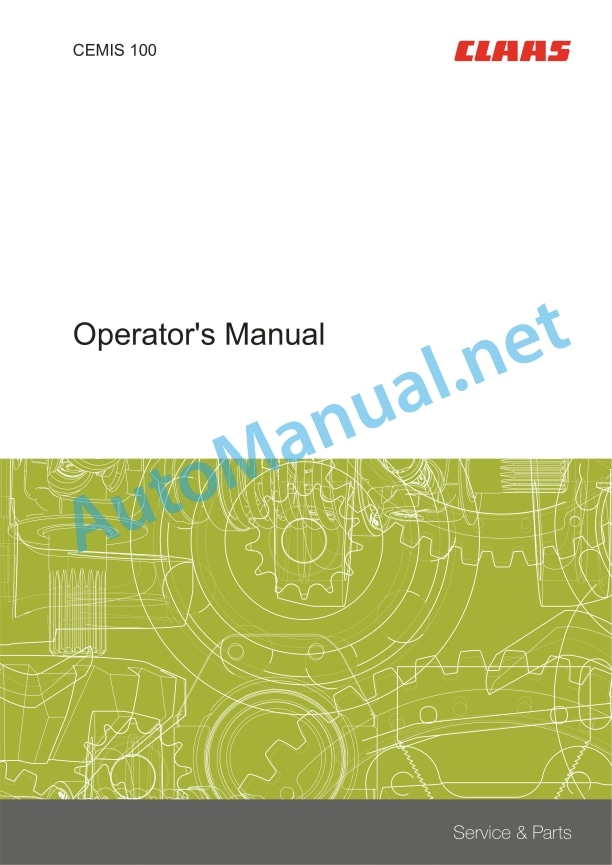Claas Disco 210 Rc (624) Mower Operator Manual EN
$50.00
- Model: Disco 210 Rc (624) Mower
- Type Of Manual: Operator Manual
- Language: EN
- Format: PDF(s)
- Size: 35.5 MB
File List:
00 0294 669 2.pdf
00 1329 399 0.pdf
00 2348 408 0.pdf
00 2348 427 0.pdf
00 0294 669 2.pdf:
DISCO 210 RC
Table of contents
1 To this operator’s manual
1.1 Notes on the manual
1.1.1 General instructions
1.1.2 Using the manual
Directions
1.1.3 Validity of manual
1.1.4 Symbols and notes
1.1.5 Technical specifications
2 Safety
2.1 Safety rules
2.1.1 Particularly important
2.1.2 Qualification of drivers and maintenance personnel
2.1.3 Intended use
2.1.4 Reasonably foreseeable misuse
2.1.5 Safety and accident prevention regulations
2.1.6 First aid measures
2.1.7 Danger of injury by hydraulic liquid
2.2 Safety decals on the machine
2.2.1 Safety decals
2.2.2 Position of hazard warning signs
3 Machine description
3.1 Overview and method of operation
3.1.1 Overview of DISCO 210 RC
3.1.2 Function of DISCO 210 RC
3.2 Optional machine equipment
3.2.1 High-cut skids
3.2.2 Bolted wear skids
3.2.3 Slip-on yoke for 8-piece universal drive shaft
3.2.4 Safety frame
3.2.5 Hydraulic system connectors, 1-fold
3.2.6 Brackets for warning plates
3.3 Identification plates and vehicle identification number
3.3.1 Position of identification plate
3.3.2 Explanation of mower unit identification plate
3.3.3 Spare parts and technical questions
4 Operating and control elements
4.1 Fitting frame
4.1.1 Shut-off tap
4.2 Mower unit
4.2.1 Pull rope
4.3 Conditioner
4.3.1 Toggle nut
5 Technical specifications
5.1 DISCO 210 RC – Type 624
5.1.1 Dimensions
5.1.2 Weights
5.1.3 Requirements for the tractor
5.1.4 Version
5.1.5 Noise level
5.1.6 Operating utilities and filling quantities
6 Machine preparation
6.1 Tractor preparation
6.1.1 Axle loads, minimum ballast, total weight
6.1.2 Calculating the minimum front ballast
6.1.3 Calculating the minimum rear ballast
6.1.4 Calculating the actual front axle load
6.1.5 Calculating the actual total weight
6.1.6 Calculating the actual rear axle load
6.1.7 Calculation table
6.2 Adapting the machine
6.2.1 Adapting the lower link pin
6.2.2 Universal drive shaft – Checking the length
6.2.3 Universal drive shaft – Adapting the length
6.2.4 Fitting the universal drive shaft to the machine
6.3 Hitching the machine
6.3.1 Hitching the headstock
6.3.2 Installing the universal drive shaft
6.3.3 Connecting the hydraulic hoses
6.3.4 Raising the jack stand
6.3.5 Laying the pull ropes
6.4 Unhitching the machine
6.4.1 Preparing the unhitching
6.4.2 Lowering the jack stand
6.4.3 Removing the pull ropes
6.4.4 Disconnecting the hydraulic hoses
6.4.5 Removing the universal drive shaft
6.4.6 Unhitching the headstock
6.5 Loading the machine
6.5.1 Loading / unloading the machine
7 Operation
7.1 General safety precautions
7.1.1 Prior to operation
7.2 Driving on the road
7.2.1 Road travel
7.2.2 Marking the machine for road travel
7.3 Fieldwork settings
7.3.1 Adjusting the headstock
7.3.2 Adjusting the mower unit load relief
7.3.3 Adjusting the cutting height
7.3.4 Setting the swath width
7.3.5 Adjusting the roller conditioner
7.3.6 Mowing without roller conditioner
7.3.7 Engaging the bump safeguard
7.3.8 Retensioning the bump safeguard
7.4 Fieldwork
7.4.1 Fieldwork
7.4.2 Swinging to transport position
7.4.3 Folding to working position
7.4.4 Machine use
7.4.5 Mowing methods
7.4.6 Turning area position
7.4.7 Instructions for mowing
7.4.8 Difficult conditions of use
7.4.9 Recommendation for environmental protection
8 Faults and remedies
8.1 Causes and remedies
8.1.1 General warnings
8.1.2 General trouble and remedy
9 Maintenance
9.1 Maintenance Information
9.1.1 General warnings
9.1.2 Electrical system
9.1.3 Protective guards
9.1.4 Spare parts
9.1.5 Unbalance
9.1.6 Compressed air and water
9.1.7 Burn prevention
9.1.8 Oils
9.1.9 Fire prevention and explosion prevention
9.1.10 Lines, tubes and hoses
9.2 Overview maintenance intervalls
9.2.1 Handling maintenance intervals
9.2.2 before the harvest
9.2.3 After the first 5 operating hours
9.2.4 After the first 10 operating hours
9.2.5 After the first 50 operating hours
9.2.6 Every 20 operating hours
9.2.7 Every 100 operating hours
9.2.8 Every 200 operating hours
9.2.9 Every 250 operating hours
9.2.10 Every 500 operating hours or annually
9.2.11 As needed
9.2.12 After the harvest
9.3 Maintenance operations in general
9.3.1 Cleaning the machine
9.3.2 Preserve the machine
9.3.3 Fastening material
9.4 Maintenance operations gearbox
9.4.1 Check the main gearbox oil level
9.4.2 Changing the main gearbox oil
9.4.3 Checking the angle drive oil level
9.4.4 Changing the angle drive oil
9.5 Maintenance operations drive shaft
9.5.1 Maintaining drive shafts
9.5.2 Roller conditioner universal drive shaft
9.6 Maintenance operations hydraulic
9.6.1 Hydraulic system
9.6.2 Hydraulic hose lines
9.6.3 Hydraulic cylinders
9.7 Mower unit maintenance work
9.7.1 Checking the mower head oil level
9.7.2 Changing the mower head oil
9.7.3 Replacing the knives
Replacing bolt-on knives
9.7.4 Checking the mower knife holder
9.7.5 Maintaining the cutting disc
Cleaning the drain opening
9.7.6 Replacing the cutting discs
9.7.7 Installing the pinion units
9.7.8 Adjusting the safety device
Front safety guard holder
9.8 Roller conditioner maintenance work
9.8.1 Tensioning the drive belt
9.8.2 Adjusting the roller conditioner
Adjusting tension springs
Adjusting synchronous operation
Adjusting the roller clearance
9.9 Attachable frame maintenance work
9.9.1 Adjusting the mower head load relief
9.10 Lubrication chart
9.10.1 Grease points – 20 h
9.10.2 Grease points – 100 h
9.10.3 Grease points – 250 h
10 Placing out of operation and disposal
10.1 General Information
10.1.1 Removal from service and disposal
11 EC-declaration of conformity
11.1 DISCO 210 RC – Type 624
11.1.1 EC Declaration of Conformity
12 Technical terms and shortcuts
12.1 Terms and explanations
12.1.1 Technical terms
12.1.2 Abbreviations
00 2348 408 0.pdf:
CEMIS 100
Table of contents
1 Introduction
1.1 General information
1.1.1 Validity of the manual
1.1.2 Information about this Operator’s Manual
1.1.3 Symbols and notes
1.2 Intended use
1.2.1 Intended use
1.2.2 Reasonably foreseeable misuse
2 Safety
2.1 Safety rules
2.1.1 General safety and accident prevention regulations
2.1.2 Interaction between terminal and machine or tractor
2.1.3 Electrocution by electrical system
3 Product description
3.1 Overview and method of operation
3.1.1 Overview of CEMIS 100
3.1.2 Function principle of CEMIS 100
3.2 Identification plates and identification numbers
3.2.1 Spare parts and technical questions
3.2.2 Identification plate of CEMIS 100
4 Operating and display elements
4.1 CEMIS 100
4.1.1 User interface for LINER
4.1.2 User interface for ROLLANT
4.1.3 User interface for UNIWRAP
5 Technical specifications
5.1 CEMIS 100
5.1.1 Specification
6 Operation
6.1 CEMIS 100
6.1.1 Operating the CEMIS 100
6.1.2 Switching CEMIS 100 on
6.1.3 Switching CEMIS 100 off
7 Maintenance
7.1 CEMIS 100
7.1.1 Daily
8 Putting out of operation and disposal
8.1 General information
8.1.1 Removal from service and disposal
9 Technical terms and abbreviations
9.1 Terms and explanations
9.1.1 Technical words
9.1.2 Abbreviations
00 2348 427 0.pdf:
CEMIS 700
Table of contents
1 Introduction
1.1 General information
1.1.1 Validity of the manual
1.1.2 Information about this Operator’s Manual
1.1.3 Symbols and notes
1.2 Intended use
1.2.1 Intended use
1.2.2 Reasonably foreseeable misuse
2 Safety
2.1 Safety rules
2.1.1 General safety and accident prevention regulations
2.1.2 Interaction between terminal and machine or tractor
2.1.3 Electrocution by electrical system
3 Product description
3.1 Overview and method of operation
3.1.1 Overview of CEMIS 700
3.1.2 Function principle of CEMIS 700
3.2 Identification plates and identification numbers
3.2.1 Spare parts and technical questions
3.2.2 Identification plate of CEMIS 700
4 Information on the product
4.1 Software version
5 Operating and display elements
5.1 CEMIS 700
5.1.1 User interface
5.1.2 Terminal program
6 Technical specifications
6.1 CEMIS 700
6.1.1 Specification
7 Operation
7.1 CEMIS 700
7.1.1 Operating the CEMIS 700
7.1.2 Switching CEMIS 700 on
7.1.3 Switching CEMIS 700 off
7.2 Terminal settings
7.2.1 Making settings
Making settings with the rotary button
Making settings with the touch function
7.2.2 Setting the screen lighting
Daytime mode
Nighttime mode
Activating automatic key lighting
7.2.3 Setting the time and date
7.2.4 Displaying diagnosis information
On-board power supply voltage display
Display of CLAAS ISOBUS ECU address and name
7.2.5 Setting the language and display formats
Setting the language
Setting display formats
7.2.6 Setting the volume
7.2.7 Deleting an ISOBUS implement
8 Maintenance
8.1 Maintenance
8.1.1 Daily
9 Putting out of operation and disposal
9.1 General information
9.1.1 Removal from service and disposal
10 Technical terms and abbreviations
10.1 Terms and explanations
10.1.1 Technical words
10.1.2 Abbreviations
John Deere Repair Technical Manual PDF
John Deere Diesel Engines PowerTech 4.5L and 6.8L – Motor Base Technical Manual 07MAY08 Portuguese
John Deere Parts Catalog PDF
John Deere Tractors 6300, 6500, and 6600 Parts Catalog CQ26564 (29SET05) Portuguese
John Deere Repair Technical Manual PDF
John Deere DF Series 150 and 250 Transmissions (ANALOG) Component Technical Manual CTM147 05JUN98
John Deere Repair Technical Manual PDF
John Deere Repair Technical Manual PDF
John Deere POWERTECH E 4.5 and 6.8 L Diesel Engines TECHNICAL MANUAL 25JAN08
John Deere Repair Technical Manual PDF
John Deere Diesel Engines POWERTECH 2.9 L Component Technical Manual CTM126 Spanish
John Deere Repair Technical Manual PDF
John Deere Repair Technical Manual PDF
John Deere Parts Catalog PDF
John Deere Tractors 7500 Parts Catalog CPCQ26568 30 Jan 02 Portuguese
John Deere Repair Technical Manual PDF
























